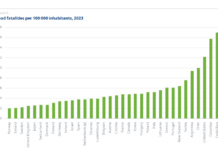Car-centric transportation systems have seriously damaged the environment, safety, and livability of cities around the world. Fossil-fuel-based passenger transport is a major contributor to greenhouse gas emissions, and the impacts of climate change are already wreaking havoc on our planet’s ecosystems and economies. As low- and middle-income countries (LMICs) increasingly urbanize and grow their economies, they could follow the dangerous path of many wealthy nations in establishing car-dominated transport systems and see similar negative outcomes. Alternatively, LMICs can forge a different path — one that prioritizes safe infrastructure for walking, cycling, and public transportation, keeps vehicle kilometers traveled to a minimum, and limits the size of personal vehicles.
Over the past two decades, cars have gotten larger, exacerbating pollution and road safety issues. SUVs are the second-largest contributor to the global increase in CO2 emissions since 2010, behind the power sector but ahead of heavy industry. As of 2022, half of the new vehicles sold globally are SUVs, up from one in five in 2010. This is not only the case in developed countries like the US and China — SUV sales have also increased in India, Indonesia, Brazil, Mexico, and other emerging economies. And they are continuing to rise: in Mexico, for example, SUVs are on track to represent more than 80% of new vehicles by 2050.
The post How to Keep SUVs Out of Emerging Economies first appeared on Institute for Transportation and Development Policy.









